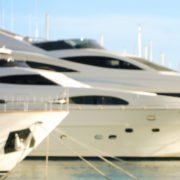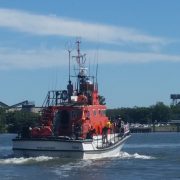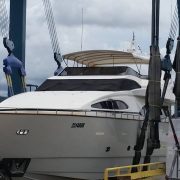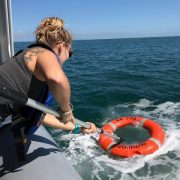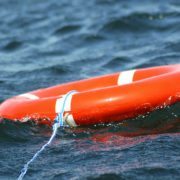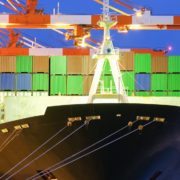Obtaining A Maritime Licence
/in Uncategorized/by ceoObtaining A Maritime Licence
Many of our inquiries are from people who are new to the Australian Domestic vessels and the marine industry who find it difficult locating the correct information required to gain a marine licence. While there is a lot of information out there, putting it together can be a mind field. So we decided to write this post to assist new comers and any one interested in the marine industry in a bid to simplify the process. 
Firstly we would ask you, “What do you want to do with your licence?”
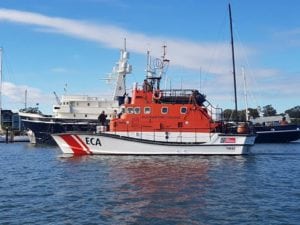
DT is ECA Maritime College’s Training Vessel
If you want to work overseas then completing the Near Coastal courses and licences will not be the best option, if you want to work on Australian vessels then the Australian Maritime Safety Authority (AMSA) endorsed courses would be the course for you.
Secondly, “Have you got any sea time on board commercially registered vessels?
For most of the Australian Commercial courses you will require a certain amount of sea time to convert your certificate you get from the college you attend to a licence to drive a boat. AMSA have a full list of these requirements on their website or you can contact our office and request a copy of the student handbook relevant to the course you wish to do. We have included all the AMSA documents in this publication to assist you in receiving all the information you require to make an informed decision as to the course you can achieve.
Thirdly, “Would you meet the AMSA medical requirements?”
Depending on which course you do as to the requirements. If you are colour blind for instance you may only be able to receive a restricted to day light sailing only. We always suggest once you have decided on the course that best suits your needs to read thoroughly through the AMSA requirements so you do not have any little surprises when you wish to convert your certificate to a licence.
There are four parts to completing this process.
1. Check your sea time is appropriate to the licence you want to achieve and could be verified by AMSA
2. Meet any additional medical or licence requirements for AMSA
3. Complete an AMSA approved course
4. Successfully complete either your AMSA Mandatory Practical Assessment or your final oral exam with AMSA to gain your licence.
We hope this information helps you and would welcome your inquiry to assist you in this process. Contact Us if you have any questions.
New Training Vessel for ECA Maritime College
/in News/by KellySpirit of Tayside / Danial Thain, she served on the cold and grey waters of the River Tay for more than 20 years. She now serves all future Australian Mariners as ECA Maritime College Training Vessel.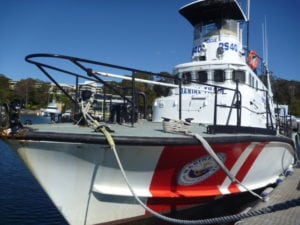
Now, after saving dozens of lives and playing a crucial role in the RNLI’s operations in the North Sea, a former Broughty Ferry lifeboat is finally getting to enjoy a well-earned retirement 9,000 miles away Down Under.
The Arun-class Spirit of Tayside, now known as the Daniel Thain, originally came to Dundee in 1978 and spent more than 20 years serving the people of the north east.
From there she went to Port Stephe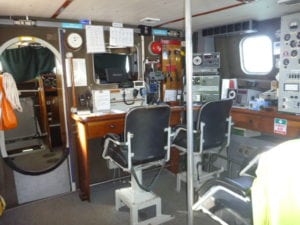 ns, a small town 150 miles north of Sydney, where hot, sunny days are more frequent than cold, rainy ones and rescuing a stranded surfer will be more likely than saving stricken fishermen.
ns, a small town 150 miles north of Sydney, where hot, sunny days are more frequent than cold, rainy ones and rescuing a stranded surfer will be more likely than saving stricken fishermen.
But having spent about 15 years in more exotic climes, it looks like almost 40 years of service will soon come to an end.
Dave Martin, operations manager at the Broughty Ferry station, said: “She has been very busy in Australia, but I’ve heard that she may finally be going into retirement.”
He told the Tele that “she was a really great boat,” but things weren’t always smooth sailing.
“Shortly after entering service the boat was knocked over twice on the way to St Andrews Bay,” said Mr Martin.
“There were a few people hurt, but this didn’t put people off. We knew she was a really sturdy boat, that was safe and could go anywhere.”
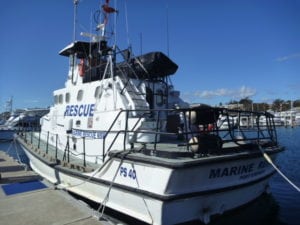
John Jack, who was a former coxswain on the boat, also recalled the times the boat was knocked over.
He said: “These boats can’t capsize but on one occasion we were as far over as we could go.
“The second coxswain broke his ankle.
“I ended up in plaster too and we thought we lost someone, but in the end, thankfully, everyone was fine.
“That one bad incident can’t take away the fact she was a very good boat.”
Mr Jack said the boat was regularly in service and attended a wide variety of call-outs.
“She would tend to deal with pleasure boats, but commercial vehicles weren’t unheard of too,” said Mr Jack.
“A few times we had to search for aircraft that came down from Leuchars and on one occasion I remember she was used to recover a pilot’s body.”
As one of the first Arun-class lifeboats to come to the station, The Spirit of Tayside was eventually replaced by a new 1.2 million vessel named Elizabeth of Glamis, after the Queen Mother, who had been patron of the RNLI from 1937 until her death in 2002.
Mr Martin remembers the day she set sail for Poole, before heading on to Australia, and described it as “very emotional”.
He said: “When she left, lots of families came down to the jetty to say their goodbyes.
“After she had been revamped down south and was getting ready to go to Australia a few of us were able to head down to Poole, with our kilts at the ready.
“There are still a few of us here in the station who remember her well and have lots of good memories.”
Danial Thain’s maiden voyage at ECA Maritime College
/in News/by KellyWe have recently purchased our own training vessel called the Danial Thain. This was our maiden voyage for the new asset to ECA Maritime College and we hope our Master 4 and Master 5 students enjoyed their course and time with ECA Maritime College.
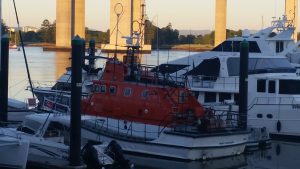
Danial Thain at first light, getting ready for her maiden voyage
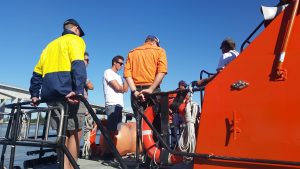
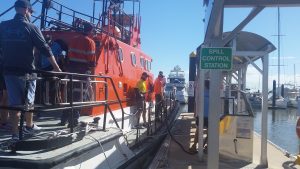
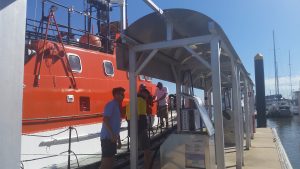
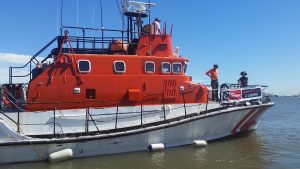
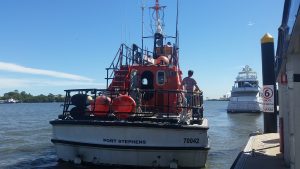

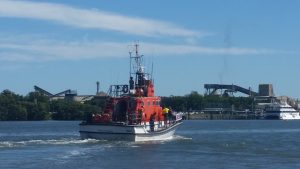
Maritime College Brisbane 2015
/in Uncategorized/by ceoWe would like to welcome everyone to a new year, there are big plans for ECA Maritime College in 2015. As a part of our due diligence each December we research what our competitors are doing in the market place. It appears our Government Competitor have had to review their process and start charging like a commercial business. So we are happy to see we can compete not only with the additional service we provide, our course time frames but for the first time in 8 years we can now compete with our course fees.
Our course fees have not been altered for the past 4 years in a bid to continue to service the industry and we still stand by ONLY engaging active mariners to teach you about your industry. Check out our testimonials, past students have frequently commented on how useful it was to attend a college who only employ active mariners to teach our students.
Click here to see our testimonials Additionally to assist all who attend our college get the attention they require to complete their studies we run small classes – up to 10 max in a class. So there is no better time to contact us regarding your training needs, we can create a course to suit your needs and welcome your inquiry.
Changes To Marine Tickets
/in Uncategorized/by ceoMARINE TICKETS – DOMESTIC QUALIFICATIONS – CERTIFICATE OF COMPETENCY
UNDER THE NEW PART D OF THE NATIONAL STANDARDS FOR COMMERCIAL VESSELS, PEOPLE SEEKING OR RENEWING A CERTIFICATE OF COMPETENCY (MARINE TICKETS) WILL BE ABLE TO APPLY FOR A FIVE YEAR NATIONAL SYSTEM CERTIFICATE BY MEETING SOME SIMPLE REQUIREMENTS. ONCE ISSUED, A CERTIFICATE OF COMPETENCY WILL ALLOW THE HOLDER TO OPERATE ANYWHERE IN AUSTRALIAN WATERS SUBJECT TO THE OPERATIONAL AND DISTANCE LIMITATIONS OF THE CERTIFICATE. THIS MEANS A PERSON WILL NO LONGER BE REQUIRED TO SEEK RECOGNITION OF THEIR CERTIFICATE BEFORE CROSSING STATE OR TERRITORIAL BORDERS. FOR MORE INFORMATION, PLEASE SEE THE QUICK GUIDE TO QUALIFICATIONS.
SEAFARERS AND QUALIFICATIONS
WORKING ON A SHIP IN AUSTRALIA
ALL DOMESTIC SEAFARERS IN AUSTRALIA ARE REGULATED UNDER THE MARINE SAFETY (DOMESTIC COMMERCIAL VESSELS) NATIONAL LAW ACT 2012.
If you work on a vessel in Australia and carry out any commercial activity, the National Law applies to you. If you work on an international vessel in Australian waters, or any vessel that operates internationally, the Navigation Act 2012 applies to you.
QUALIFICATIONS
Before you can work on a domestic commercial vessel in Australia, you will need to get a Certificate of Competency. This proves you are capable to master a vessel and its passengers.
Reference to AMSA website with regard to information provided.
Why We Do What We Do?
/in Uncategorized/by ceoECA Maritime College was developed by mariners for mariners, it is important we only engage professional mariners to teach the future mariners of Australia.
There is a very well-known saying – “Those who can’t do, TEACH”
If you can’t do OR you don’t do OR you have lost your passion, you should not be teaching.
As professional mariners, our trainers will either be working with or sailing next to their graduates one day, they would look somewhat foolish if they got run over by one of their graduates. This combination has proven success, it is important not only to the founders of the company, but to all the trainers that our graduates are knowledgeable of their chosen field before they receive their qualification.
Since inception in 2007 we have evolved and expanded our services to follow industry demands. During this time we have had enquiries from people who are seeking a career change. A marine licence is very much like getting a drivers licence, logged drive/sea time must be presented to the Department of Transport, if the relevant time at sea is not produced converting a qualification to a licence will not be possible.
Maritime Commercial Services is a new division and provides a service to companies and people who need their vessels delivered or moved at sea. We provide professional crew and management team to organise all aspects of these deliveries, from flying crew to the vessel, organising ship yards, berthing and pilotage services if required. Providing the students on our database have the manning requirement we can offer them paid positions on board these deliveries.
ECA Maritime College will continue to grow; we will continue to listen to the industry and strive to break new ground in training the future mariners of Australia. We are all passionate and driven to produce positive results and a high standard of mariners.
Welcome to ECA Maritime College
/in Uncategorized/by ceoWelcome to ECA Maritime College blog. With all the changes in the maritime industry and the confusion in the marketplace we decided to provide information to help clarify some of these. Australian Maritime Safety Authority (AMSA) will replace all state maritime authorities with regards to issuing near coastal licences and will be servicing the marine industry via the local marine authority office.
When a candidate completes their studies they will still be required to complete the additional requirements as per the guidance notices located on the AMSA website relevant to the marine licence being applied for. The major change to licence’s is, all newly issued licences will now be recognised nationally, so if you are operating on a vessel that crosses the magical border line from NSW to QLD there is no longer a requirement to notify the authority of passing the border. These licences are recognised in ALL Australian water.
If you are the holder of the old state licences when it is revalidated it will be re- issued as a national licence. AMSA will accept your revalidation application prior to your revalidation date, once all the requirements have been met and the fees are paid, however if the area of operation and the current job does not require a national licence then there is no need to do anything. If your situation is different to any of the above and you are still confused please contact your local maritime authority office AMSA directly.
STCW 10, Certificate of Safety Training
/in Uncategorized/by ceoSTCW 10, Certificate of Safety Training
We are running our final step in our AMSA Audit, this includes running our first STCW 10 Certificate of Safety Training. We are not currently listed on the AMSA website as a provider because we have not finalised our STCW 10 Audit. However if you wish to enroll in the STCW 10 full course and would like to contact AMSA to confirm our status please email me ceo@ecamaritimecollege.edu.au for a contact.

Once we complete this final process we will be able to conduct refresher courses in Brisbane using state of the art facilities. All our Fire Fighting for this course in Brisbane will be run at the Whyte Island Fire Training Center and our pool activities will be at Centenary High Dive swimming pool .
Your support will enable this to be a reality. We hope this will be the first of many Blue Water courses on offer at our Brisbane facility.
We are very conveniently located, just 10 minutes from the Brisbane Airport. Very cheap accommodation close to our facilities. The course will run 8 days consecutively, if you need your First Aid please let us know and we can arrange for this to be offered at the end of your main course.
All of our trainers are active mariners, we offer from Coxswain to Master 4, MED 3, 2 & 1 and have been servicing the marine industry for the past 10 years.
Contact us if you have a group of 10 crew who you need trained, we will run dedicated training for you and your crew, some of our corporate clients include Austral Fisheries, Australian Border Force, Raptis and Sons, Port of Brisbane …
For more information or to contact us
AMSA Launches SMS Resource Kit
/in Uncategorized/by ceoAMSA Launches SMS Resource Kit
AMSA successfully launched the Safety Management System (SMS) resource kit in Hobart earlier this month.
This kit has been designed to help industry and commercial vessel operators comply with operational safety requirements. It is particularly important to meet the upcoming July 2015 date for passenger and hire and drive vessels.

Vessel Owners and Safety Management System
Owners have a duty to ensure the safety of the vessel and its operation. This includes the implementation and maintenance of a Safety Management System to ensure the vessel and operations are safe.
What is a Safety Management System?
A Safety Management System (SMS) is the manner in which your company and you proactively identify and manage risks to develop a culture of safety. The owner of the vessel is responsible for developing, documenting and implementing an SMS.
Your SMS should be relevant, practical and effective to your organisation and it should be tailored to reflect what you do in your operation and on your vessel. You must involve the crew, particularly when identifying your risks and developing your procedures.
An SMS may be combined with other administrative and management systems of the vessel such as occupational health and safety, fisheries, food safety, quarantine, environmental or general management.
What is the benefit of having a Safety Management System?
A documented SMS clearly sets out your organisation’s approach to safety. It promotes clear understanding of the safety system and consistency in its application at all levels of the business. Importantly, it provides tangible evidence of the precautions you have taken should the sufficiency of your vessel’s safety system be brought into question following an incident or accident.
When is a Safety Management System effective?
An SMS is only effective when it successfully identifies hazards, controls risk and is clearly understood by everyone directly involved with your vessel’s operation.
What additional benefit will I get from a Safety Management System?
An SMS provides a clear and consistent approach to vessel safety management and a foundation for the development of a safety culture. A safety culture means that there is a commitment at all levels within your organisation to safety. A safety culture also spreads safety awareness that is present at all times during the performance of daily duties and responsibilities.
About Us
We have been servicing the maritime sector for the past 20+ years both working in it and training it.
We are the TAFE alternative.
Office Hours
Administration
Mon – Thur
0800 – 1600
Friday 0800 – 1300
Sat & Sun: Closed



